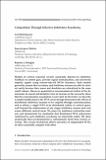Competition Through Selective Inhibitory Synchrony
Author(s)
Rutishauser, Ueli; Slotine, Jean-Jacques E.; Douglas, Rodney J.
DownloadRutishauser-2012-Competition Through Selective Inhibitory Synchrony.pdf (641.3Kb)
PUBLISHER_POLICY
Publisher Policy
Article is made available in accordance with the publisher's policy and may be subject to US copyright law. Please refer to the publisher's site for terms of use.
Terms of use
Metadata
Show full item recordAbstract
Models of cortical neuronal circuits commonly depend on inhibitory feedback to control gain, provide signal normalization, and selectively amplify signals using winner-take-all (WTA) dynamics. Such models generally assume that excitatory and inhibitory neurons are able to interact easily because their axons and dendrites are colocalized in the same small volume. However, quantitative neuroanatomical studies of the dimensions of axonal and dendritic trees of neurons in the neocortex show that this colocalization assumption is not valid. In this letter, we describe a simple modification to the WTA circuit design that permits the effects of distributed inhibitory neurons to be coupled through synchronization, and so allows a single WTA to be distributed widely in cortical space, well beyond the arborization of any single inhibitory neuron and even across different cortical areas. We prove by nonlinear contraction analysis and demonstrate by simulation that distributed WTA subsystems combined by such inhibitory synchrony are inherently stable. We show analytically that synchronization is substantially faster than winner selection. This circuit mechanism allows networks of independent WTAs to fully or partially compete with other.
Date issued
2012-06Department
Massachusetts Institute of Technology. Department of Mechanical Engineering; Massachusetts Institute of Technology. Nonlinear Systems LaboratoryJournal
Neural Computation
Publisher
MIT Press
Citation
Rutishauser, Ueli, Jean-Jacques Slotine, and Rodney J. Douglas. “Competition Through Selective Inhibitory Synchrony.” Neural Computation 24.8 (2012): 2033–2052. © 2012 The MIT Press
Version: Final published version
ISSN
0899-7667
1530-888X